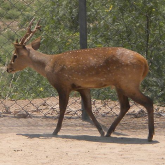Hog deer
Alert
Have you seen Hog deer?
Be on the lookout for Hog deer and report it to Biosecurity Queensland. Early detection and reporting are the key elements in preventing Hog deer from becoming a major problem in Queensland.
Call us on 13 25 23.

Hog deer
© Prachanart Viriyaraks Creative Commons

Hog deer side view
Shutterstock

Hog deer
© Khalid Mahmood Creative Commons

Hog deer front view
© Lip Kee Creative Commons
Native from Pakistan and India through to Myanmar, hog deer is the smallest of the 6 species of deer in Australia. They were introduced into Victoria, Australia in the late 1860s and are well established in the Gippsland coastal area. In 2004, populations were identified in South Australia and New South Wales. Hog deer could potentially thrive in Queensland.
You must not move, keep, feed, give away, sell or release hog deer into the environment.
You must report all sightings to Biosecurity Queensland within 24 hours.
Scientific name
Other names
- Indian hog deer
Similar species
Description
- Small deer species, with stags standing about 70cm at shoulder and weighing up to 50kg, hinds smaller standing 61cm and weighing about 30kg.
- Coat is thick, uniform dark-brown in winter, with lighter undersides.
- Summer coat changes to rich reddish brown. Many hog deer show a dark dorsal stripe from the back of the head down the spine. In summer pale-coloured dots can appear either side of the dorsal stripe from shoulder to rump.
- Tail is short 15–20cm, brown, tipped with white. Underside of the tail is white, the deer can fan it out when alarmed.
- Stags carry 3-tined antlers on solid main beam, usually 30–38cm long. Distinctive features of hog deer antlers are the acute angles between the brow tine and main beam and that the inner tops tend to be short and angle back from the main beam and across towards the opposite antler.
Habitat
- Found in tropical or subtropical climates.
- Prefers floodplains, swamps and wet grasslands.
- Permanent water is essential and has major influence on range.
Distribution
- Not found in the wild.
Life cycle
- Lives solitary or in pairs, mother and offspring. Larger groupings can feed together.
- Breeding is seasonal, the peak rut occurs in September–October.
- Adult hinds give birth after gestation of about 220–230 days.
- Typical only 1 fawn, sometimes twins.
Crops affected
- Agricultural crops, pasture, forestry plantations, gardens.
Impacts
Environmental
- Can damage natural environment by eating native vegetation, damaging trees, dispersing weed seeds, and fouling water.
Economic
- Can damage forestry seedlings, agricultural and horticultural crops, commercial flower crops, orchards, irrigation systems and fences.
- In dry seasons, can compete with sheep and cattle for pasture and supplementary feed.
Social
- Can be traffic hazard and cause car accidents in rural areas (generally not found near urban areas).
Control
- Before undertaking any preventative or control actions, contact our Customer Service Centre.
Shooting
- Shooting must be carried out by trained personnel with appropriate firearms licences. Shooters must possess necessary skill and judgment to kill deer with a single shot. Lactating females should not be targeted but, if they are inadvertently shot, young should be found and euthanased.
Ground shooting
- Although time-consuming and labour-intensive, ground shooting is the most effective and humane technique for reducing deer populations. Usually done at night from vehicle with spotlights.
Helicopter shooting
- Helicopter shooting is effective in inaccessible areas such as broadacre crops, swamps and marshes. However, most new deer populations in Queensland are at comparatively low densities and in areas of thick cover where helicopter shooting is unlikely to be an economical option. Helicopter shooting also risks disturbing and dispersing deer populations.
Trapping
- Trapping may be an option for deer control in some circumstances. Simplest form involves self-mustering trap.
- Traps must be monitored and deer promptly tranquillised or euthanased after trapping. Deer mortalities of 3–7% post-trapping have been recorded in US studies, and animal welfare issues must be considered when using this method.
Legal requirements
- The hog deer is a category 2, 3, 4, 5 and 6 restricted invasive animal under the Biosecurity Act 2014.
- You must not move, keep, feed, give away, sell or release into the environment.
- You must report all sightings to Biosecurity Queensland within 24 hours.
- You must take all reasonable and practical measures to minimise the biosecurity risks associated with dealing with hog deer under your control. This is called a general biosecurity obligation (GBO).
- At a local level, each local council must have a biosecurity plan that covers invasive plants and animals in its area. This plan may include actions to be taken on hog deer. Some of these actions may be required under local laws. Contact your local council for more information.
Further information
- Contact the Customer Service Centre